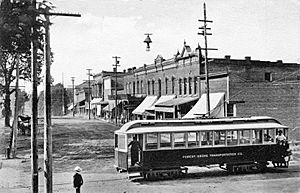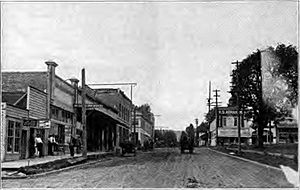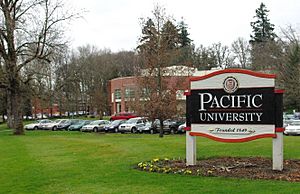Forest Grove, Oregon facts for kids
Quick facts for kids
Forest Grove, Oregon
|
||
|---|---|---|
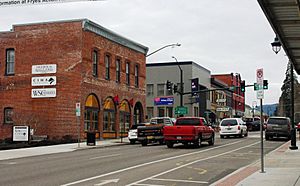
Pacific Avenue in downtown Forest Grove
|
||
|
||
| Motto(s):
"A place where families and businesses thrive."
|
||
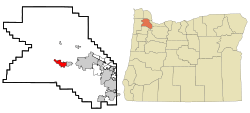
Location in Oregon
|
||
| Country | United States | |
| State | Oregon | |
| County | Washington | |
| Incorporated | 1872 | |
| Area | ||
| • Total | 6.03 sq mi (15.61 km2) | |
| • Land | 5.89 sq mi (15.26 km2) | |
| • Water | 0.14 sq mi (0.35 km2) | |
| Elevation | 190 ft (60 m) | |
| Population
(2020)
|
||
| • Total | 26,225 | |
| • Density | 4,451.71/sq mi (1,718.78/km2) | |
| Time zone | UTC−8 (Pacific) | |
| • Summer (DST) | UTC−7 (Pacific) | |
| ZIP code |
97116
|
|
| Area code(s) | 503 and 971 | |
| FIPS code | 41-26200 | |
| GNIS feature ID | 2410518 | |
Forest Grove is a city in Washington County, Oregon, United States. It is about 25 miles (40 km) west of Portland. Forest Grove started as a small farming town. Today, many people who live there travel to work in the larger Portland area.
The city was settled in the 1840s and officially became a city in 1872. This makes it the first city to be incorporated in Washington County. In 2020, about 26,225 people lived in Forest Grove.
Forest Grove is located in the Tualatin Valley. Important roads like Oregon Route 8 and Oregon Route 47 go through the city. Pacific University is a big part of Forest Grove's history and is a well-known landmark. Some buildings in the city, like Old College Hall at Pacific University, are listed on the National Register of Historic Places because they are very old and important.
Contents
History of Forest Grove
Before the 1840s, the Atfalati band of the Kalapuya Native American tribe lived in the area that is now Forest Grove.
In 1841, Alvin T. and Abigail Smith were some of the first settlers to arrive using the Oregon Trail. They settled in a place first called West Tualatin Plain. Alvin T. Smith became the community's first postmaster in 1850. His log cabin was used as the post office.
The name Forest Grove was chosen on January 10, 1851. This happened at a meeting for Tualatin Academy, which later became Pacific University. A resident named J. Quinn Thornton suggested the name. He had also used it for his own home. The name refers to a group of oak trees that are still on the university campus today. The city was officially planned out in 1850.
In 1860, Forest Grove had 430 people. It was officially made a city by the state in 1872. This was the first city in Washington County to be incorporated. In 1880, a school for Native American children, now called Chemawa Indian School, opened in the city. It later moved to Salem in 1884. The city started its Fire Department in 1894. By 1900, the population had grown to almost 1,300 people.
In 1908, the Oregon Electric Railway started serving the city. In 1914, another railroad company, Southern Pacific, also opened a line. Both railroads carried goods and passengers. Passenger service by these railroads ended in the 1920s and early 1930s.
In February 2016, some people in Forest Grove heard a strange, high-pitched noise. It became known as the Forest Grove Sound.
Forest Grove has many historic buildings. There are 12 properties listed on the National Register of Historic Places. There are also two historic areas: the Clark Historic District and the Painter's Woods Historic District. These include the Alvin T. Smith House, the First Church of Christ, Scientist, and Old College Hall.
The Oregon Army National Guard's 2nd Battalion-218th Field Artillery Regiment has its main office in Forest Grove.
Geography and Climate
Forest Grove is on the western edge of the Portland area and the Willamette Valley. The city covers about 5.88 square miles (15.23 square kilometers). Most of this is land, with a small amount of water.
One of the largest Giant Sequoia trees in Oregon can be found in Forest Grove.
Climate in Forest Grove
Forest Grove has a climate with warm, dry summers. The average monthly temperatures do not get very hot. This type of weather is called a warm-summer Mediterranean climate.
| Climate data for Forest Grove (1991–2020 normals, extremes 1893-present) | |||||||||||||
|---|---|---|---|---|---|---|---|---|---|---|---|---|---|
| Month | Jan | Feb | Mar | Apr | May | Jun | Jul | Aug | Sep | Oct | Nov | Dec | Year |
| Record high °F (°C) | 67 (19) |
77 (25) |
82 (28) |
93 (34) |
101 (38) |
113 (45) |
109 (43) |
108 (42) |
104 (40) |
93 (34) |
72 (22) |
64 (18) |
113 (45) |
| Mean maximum °F (°C) | 57.4 (14.1) |
61.1 (16.2) |
70.3 (21.3) |
79.6 (26.4) |
88.9 (31.6) |
92.5 (33.6) |
98.6 (37.0) |
98.7 (37.1) |
93.8 (34.3) |
80.0 (26.7) |
64.3 (17.9) |
56.8 (13.8) |
101.8 (38.8) |
| Mean daily maximum °F (°C) | 45.0 (7.2) |
49.4 (9.7) |
54.6 (12.6) |
60.1 (15.6) |
68.1 (20.1) |
73.1 (22.8) |
81.4 (27.4) |
82.2 (27.9) |
76.1 (24.5) |
63.3 (17.4) |
50.9 (10.5) |
44.0 (6.7) |
62.4 (16.9) |
| Daily mean °F (°C) | 38.8 (3.8) |
41.2 (5.1) |
45.2 (7.3) |
49.6 (9.8) |
56.7 (13.7) |
61.4 (16.3) |
67.6 (19.8) |
67.9 (19.9) |
62.4 (16.9) |
52.4 (11.3) |
43.6 (6.4) |
38.4 (3.6) |
52.1 (11.2) |
| Mean daily minimum °F (°C) | 32.6 (0.3) |
33.1 (0.6) |
35.9 (2.2) |
39.2 (4.0) |
45.3 (7.4) |
49.7 (9.8) |
53.8 (12.1) |
53.5 (11.9) |
48.7 (9.3) |
41.6 (5.3) |
36.3 (2.4) |
32.8 (0.4) |
41.9 (5.5) |
| Mean minimum °F (°C) | 21.1 (−6.1) |
22.8 (−5.1) |
27.5 (−2.5) |
30.4 (−0.9) |
35.6 (2.0) |
41.4 (5.2) |
45.7 (7.6) |
45.6 (7.6) |
39.6 (4.2) |
31.0 (−0.6) |
24.7 (−4.1) |
20.7 (−6.3) |
15.7 (−9.1) |
| Record low °F (°C) | −11 (−24) |
−12 (−24) |
13 (−11) |
23 (−5) |
28 (−2) |
32 (0) |
34 (1) |
33 (1) |
27 (−3) |
20 (−7) |
6 (−14) |
−4 (−20) |
−12 (−24) |
| Average precipitation inches (mm) | 7.19 (183) |
5.76 (146) |
5.03 (128) |
3.33 (85) |
2.19 (56) |
1.40 (36) |
0.32 (8.1) |
0.51 (13) |
1.34 (34) |
3.70 (94) |
7.23 (184) |
8.72 (221) |
46.72 (1,187) |
| Average snowfall inches (cm) | 0.6 (1.5) |
0.6 (1.5) |
0.0 (0.0) |
0.0 (0.0) |
0.0 (0.0) |
0.0 (0.0) |
0.0 (0.0) |
0.0 (0.0) |
0.0 (0.0) |
0.2 (0.51) |
0.0 (0.0) |
1.3 (3.3) |
2.7 (6.9) |
| Average precipitation days (≥ 0.01 in) | 18.6 | 15.0 | 17.2 | 15.9 | 11.2 | 8.1 | 2.4 | 2.9 | 5.4 | 11.4 | 18.6 | 19.4 | 146.1 |
| Average snowy days (≥ 0.1 in) | 0.2 | 0.1 | 0.0 | 0.0 | 0.0 | 0.0 | 0.0 | 0.0 | 0.0 | 0.0 | 0.0 | 0.3 | 0.6 |
| Source: NOAA | |||||||||||||
People of Forest Grove
| Historical population | |||
|---|---|---|---|
| Census | Pop. | %± | |
| 1880 | 547 | — | |
| 1890 | 668 | 22.1% | |
| 1900 | 1,096 | 64.1% | |
| 1910 | 1,772 | 61.7% | |
| 1920 | 419 | −76.4% | |
| 1930 | 362 | −13.6% | |
| 1940 | 2,449 | 576.5% | |
| 1950 | 4,343 | 77.3% | |
| 1960 | 5,628 | 29.6% | |
| 1970 | 8,275 | 47.0% | |
| 1980 | 11,499 | 39.0% | |
| 1990 | 13,559 | 17.9% | |
| 2000 | 17,708 | 30.6% | |
| 2010 | 21,083 | 19.1% | |
| 2020 | 26,225 | 24.4% | |
| U.S. Decennial Census 2018 Estimate |
|||
Forest Grove in 2020
In 2020, Forest Grove had 26,225 people. There were 9,356 homes. About 23.8% of these homes had children under 18 living in them. Many families live in Forest Grove.
The people living in Forest Grove come from many different backgrounds. About 68.1% of residents were White. About 27.2% of the population were Hispanic or Latino.
Forest Grove in 2010
In 2010, there were 21,083 people living in Forest Grove. The city had 7,385 households. About 37.4% of these households had children under 18.
The average age of people in Forest Grove was 32.7 years. About 26.6% of residents were under 18 years old.
Fun Things to Do in Forest Grove
Forest Grove hosts many events and festivals each year.
- A sidewalk chalk art festival takes place in September. It started in 1990.
- A holiday light parade is held on Main Street on the first Saturday of December.
The Valley Arts Association is in downtown Forest Grove. It started in 1966 and is one of the oldest art groups in the Pacific Northwest run by volunteers. They have a gallery where you can see and buy art made by local artists. They also offer classes in things like pottery, painting, and drawing.
The historic Star Theatre in Forest Grove was built in 1912. It used to show movies and live plays. In 1969, a group called Theatre in the Grove started. Their volunteers now put on live plays at the theater.
Schools and Learning
The main landmark in Forest Grove is Pacific University. It is a private college. Its important buildings include Old College Hall and Marsh Hall.
Forest Grove, along with nearby areas like Gales Creek and Dilley, are all part of the Forest Grove School District.
Getting Around Forest Grove
Forest Grove is part of the TriMet district, which provides public transportation. You can take the TriMet bus line 57-TV Highway/Forest Grove. This bus runs every day and connects Forest Grove to Hillsboro and Beaverton. In Hillsboro, you can connect to the MAX light rail system, which goes to the wider Portland area.
Another bus line, Yamhill County Transit Area (YCTA) bus line 33-Hillsboro/MAX, also stops in Forest Grove on weekdays. It goes from Hillsboro to other towns like Gaston and McMinnville.
Forest Grove also has a free bus service called "GroveLink." It is a non-profit service run by Ride Connection and travels through the city's neighborhoods.
Sister City
Forest Grove has a sister city. This means it has a special friendly relationship with a city in another country.
Famous People from Forest Grove
Many interesting people have connections to Forest Grove, including:
- Tabitha Moffatt Brown
- Joseph Conrad Chamberlin
- Bobby Chouinard
- Harvey L. Clark
- Aubrey Gordon
- Haley Heynderickx
- Nellie Owens
- Zac Rosscup
- Alvin T. Smith
- Richard VanGrunsven
Forest Grove in Movies and TV
Forest Grove has been a filming location for TV shows.
- In the 1990s, the TV show Nowhere Man filmed in Forest Grove many times.
- In 2015, an episode of The Librarians was filmed at Pacific University and other spots in the city. The historic Forest Theater even showed the episode for free when it aired on TV.
- The 2019 series Pretty Little Liars: The Perfectionists was also filmed in Forest Grove, mostly at Pacific University.
See also
 In Spanish: Forest Grove para niños
In Spanish: Forest Grove para niños



